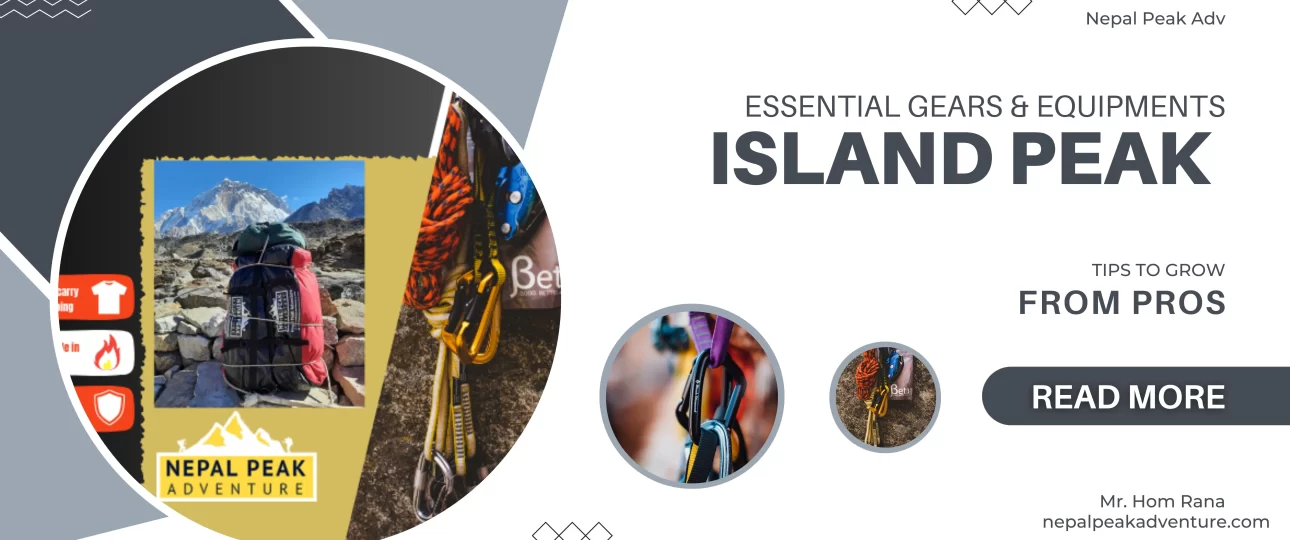Essential Gear for Island Peak Climbing: A detailed guide to the Equipment and Gear
Island Peak climbing is a challenging and rewarding activity standing at an elevation of 6,189 meters (20,305 feet) which offers a thrilling experience and breathtaking views of the surrounding Himalayan peaks.
As Island Peak Climbing is also known as the top 5 easiest climbing peaks as well as the top 5 popular peaks in Nepal, you need to have knowledge about the importance of gear and equipment. Here, in this guide, we will summarize the importance & essential gear for Island Peak Climbing and lists.
Table of Contents
A. Importance of having the right gear for a successful climb
When embarking on the Island Peak climbing expedition, having the appropriate gear is crucial for a safe and successful ascent. The right equipment not only enhances comfort and performance but also ensures protection against the harsh mountain environment. This section will emphasize the significance of selecting suitable gear, highlighting its role in maximizing safety and increasing the chances of a successful climb.
I. Clothing and Layering System
| Gear | Importance |
| Base layers | Helps to keep your body dry and comfortable. |
| Insulating Layers | To keep the body warm and trap body heat. |
| Shell Layers | Protection against rain, wind, and snow. |
| Accessories (Gloves, Hats, Socks, etc) | Gloves, Hats, socks, & other accessories to prevent injuries. |
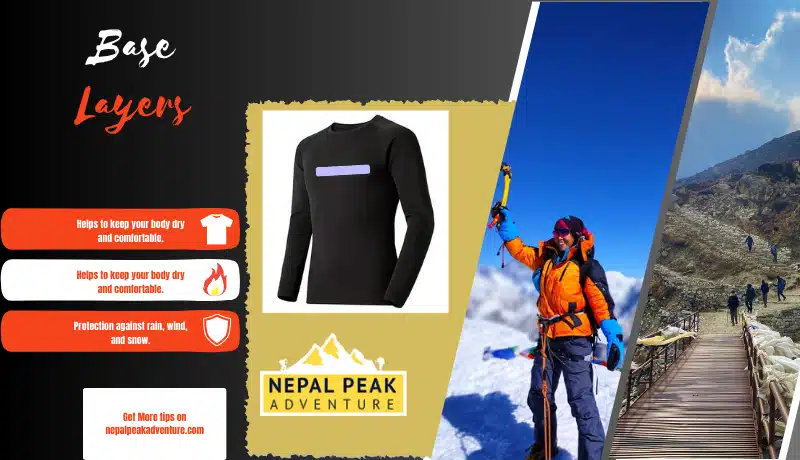
Base layers
Base layers are the foundation of your clothing system for Island Peak climbing. They consist of moisture-wicking tops and bottoms made of materials like Merino wool or synthetic fabrics.
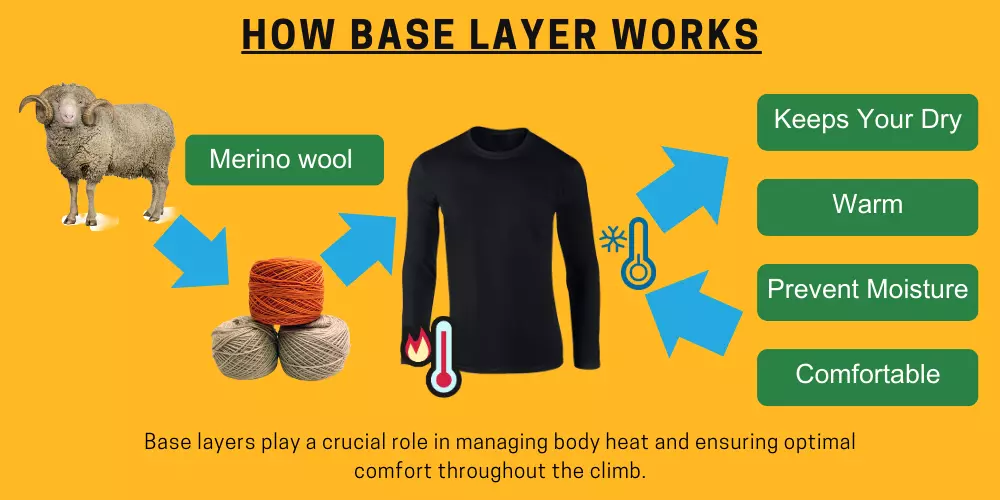
Base layers help regulate body temperature by keeping you dry and comfortable during physical exertion. They efficiently wick sweat away from the skin, preventing moisture buildup that can lead to discomfort and hypothermia in cold environments. By maintaining a dry and insulated layer next to your skin, base layers play a crucial role in managing body heat and ensuring optimal comfort throughout the climb.
Insulating layers
Insulating layers provide warmth and insulation in cold weather conditions encountered during Island Peak climbing. These layers typically include fleece jackets, down vests, and insulated jackets.
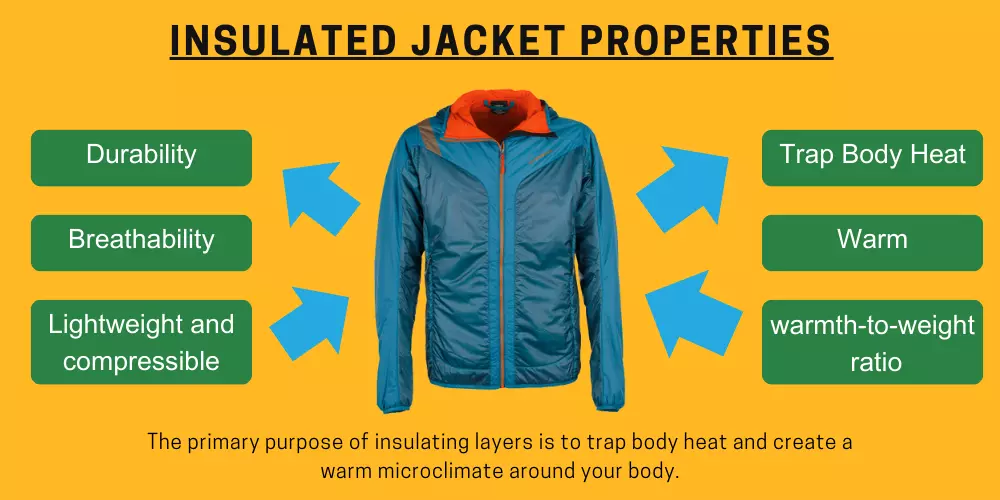
The primary purpose of insulating layers is to trap body heat and create a warm microclimate around your body. They are designed to provide an excellent warmth-to-weight ratio, ensuring that you stay cozy without adding excessive bulk or hindering mobility. Insulating layers are essential for maintaining a comfortable body temperature during rest breaks, high altitudes, and cold weather conditions.
Shell layers
Shell layers are the outermost layer of your clothing system and provide protection against wind, rain, snow, and other harsh elements. These layers include waterproof and windproof jackets and pants, commonly made from materials like Gore-Tex or similar breathable fabrics.
The shell layers act as a barrier, preventing moisture from penetrating and keeping you dry in wet conditions. They also shield you from wind chill, which can rapidly decrease body temperature. Additionally, shell layers should have proper ventilation options to allow sweat evaporation, preventing overheating during strenuous climbs.
Accessories (Gloves, hats, socks, etc.)
Accessories play a crucial role in providing additional protection and comfort during Island Peak climbing. Gloves, such as liner gloves, fleece gloves, and mountaineering gloves, keep your hands warm, maintain dexterity, and protect against frostbite.
Hats, including warm hats, balaclavas, and head scarves, help retain heat and protect your head and ears from cold temperatures. Socks, especially wool or synthetic hiking socks, provide insulation, and moisture-wicking properties, and prevent blisters. These accessories are essential for maintaining comfort, preventing injuries, and ensuring optimal performance in varying weather conditions.
Proper selection and layering of clothing are vital for Island Peak climbing to adapt to changing weather conditions, maintain body temperature, and protect against the elements. Each layer serves a specific purpose in the overall clothing system, working together to keep you comfortable, dry, and safe throughout your expedition.
II. Footwear
| Gears | Importance |
| Mountaineering Boots | To provide stability and to prevent minor injuries like blisters |
| Crampons and Gaiters | To safely ascend or descend steep slopes or icy paths. |
| Socks and Liners | They help reduce friction and manage moisture, reducing the risk of blisters. |
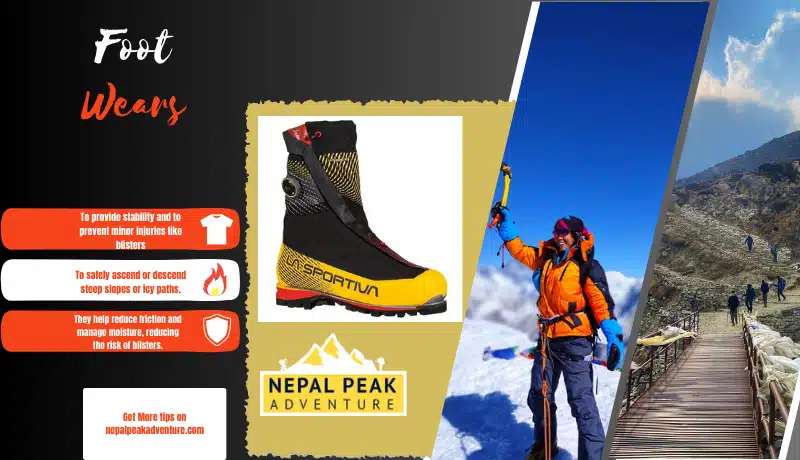
Mountaineering boots
Mountaineering boots are a crucial gear component for Island Peak climbing. These boots are specifically designed to provide stability, protection, and traction in rugged mountain terrains.
They have a stiff sole for better support and to accommodate crampons. Mountaineering boots are typically insulated to keep your feet warm in cold conditions and have a waterproof outer layer to keep your feet dry when crossing snowy or wet areas. The proper fit of mountaineering boots is essential to prevent blisters and maintain comfort during long hours of climbing. Investing in high-quality mountaineering boots will ensure durability and reliable performance throughout your expedition.
Crampons and gaiters
Crampons are traction devices that attach to your mountaineering boots to improve mobility on icy and snowy surfaces. They consist of metal spikes or points that provide grip and prevent slipping.
Crampons are crucial for safely ascending and descending steep slopes, icy sections, and glaciers encountered during Island Peak climbing. Gaiters, on the other hand, are protective covers worn over your boots and lower legs. They provide additional protection against snow, ice, and debris from entering your boots.
Gaiters also help keep your legs dry and prevent water or snow from seeping into your socks. The combination of crampons and gaiters ensures traction, stability, and protection while navigating challenging terrain.
Socks and liners
Socks and liners are essential for maintaining foot comfort and preventing blisters during Island Peak climbing. It is recommended to wear a combination of liner socks and heavyweight wool or synthetic socks. Liner socks are thin, moisture-wicking socks worn next to the skin.
They help reduce friction and manage moisture, reducing the risk of blisters. Wool or synthetic socks provide insulation, cushioning, and moisture-wicking properties to keep your feet warm and dry. It is crucial to select socks that fit well and provide adequate support and padding. Properly layered socks and liners improve circulation, reduce friction, and enhance overall foot comfort during long and strenuous climbs.
Check out “Guide to proper acclimatization for peak climbing”
III. Climbing Equipment
| Gears | Importance |
| Harness | Secure you to a rope or anchor and distribute the force of falls or hanging. |
| Helmet | Protect the head from icefall, rockfalls, and any unforeseen event. |
| Ice axe and Ice tools | Navigate icy slopes, vertical walls and to help ascend or descend. |
| Crampons | To climb steep slopes by digging a hole into the ice and attaching a rope. |
| Climbing ropes | To climb steep slopes by digging a hole into the ice and attaching a rope . |
| Carabiners and quickdraws | To climb steep slopes by digging a hole into the ice and attaching a rope. |
| Ascenders and descenders | To make ascending easy. |
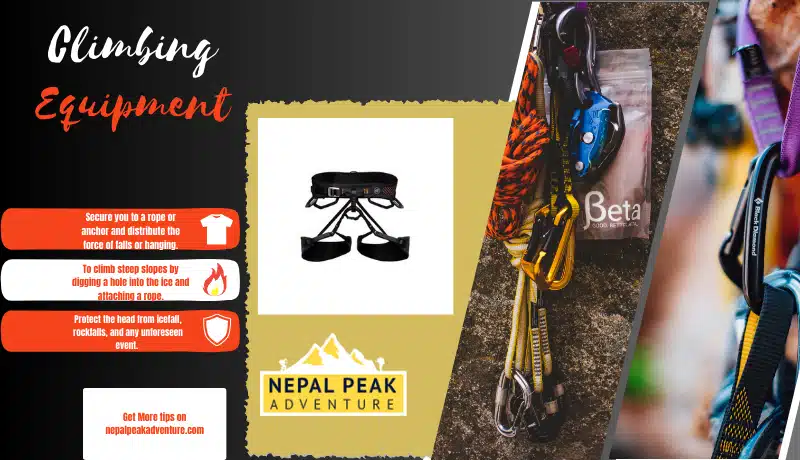
Harness
A harness is a vital piece of climbing equipment that ensures your safety during Island Peak climbing. It is a strap worn around the waist and thighs, designed to secure you to a rope or anchor.
A properly fitted harness distributes the force of falls or hanging positions, reducing the risk of injury. It provides a secure attachment point for connecting carabiners, ropes, and other gear. When choosing a harness, comfort, adjustability, and durability are key considerations. A well-fitted harness allows for freedom of movement while providing the necessary support and protection during climbs.
Helmet
Wearing a helmet is essential for protecting your head from falling objects, rockfall, or accidental impacts during Island Peak climbing. It provides crucial head protection in case of a fall or any unforeseen event.
A climbing helmet should be lightweight, comfortable, and have a secure fit. It is important to choose a helmet that meets safety standards and offers adequate coverage to protect your entire head, including the sides and back. Wearing a helmet significantly reduces the risk of head injuries and ensures your safety while ascending and descending on rocky terrain.
Ice axe and Ice tools
Ice axes and ice tools are essential tools for Island Peak climbing, particularly for navigating icy slopes and vertical ice walls. An ice axe is a versatile tool with a straight shaft and a curved pick, used for self-arrest, cutting steps, and providing stability while climbing on icy surfaces.
Ice tools, also known as ice axes or ice hammers, have a more aggressive design with curved picks on both ends and are primarily used for technical ice climbing. These tools provide grip and support, enabling climbers to ascend and descend safely in icy conditions
Crampons
Crampons are traction devices that attach to your footwear, providing grip and stability on icy and snowy terrain. They have metal spikes or points that dig into the ice, allowing you to maintain traction and prevent slips and falls.
Crampons are essential for climbing steep slopes, traversing glaciers, and navigating icy sections encountered during Island Peak climbing. Choosing crampons with the appropriate size, fit, and compatibility with your boots is crucial for optimal performance and safety.
Climbing ropes
Climbing ropes are an indispensable part of Island Peak climbing, providing safety and protection during ascents and descents. Dynamic ropes are commonly used for belaying and absorbing the shock of falls. They are designed to stretch, reducing the impact force on both the climber and the gear. Static ropes, on the other hand, are used for fixed lines and rappelling.
These ropes do not stretch and provide stability and support when ascending or descending vertical sections. Using ropes properly, along with the necessary knots and techniques, ensures the safety and efficient progression on the mountain.
Carabiners and quickdraws
Carabiners and quickdraws are essential components for securing ropes, connecting gear, and building anchors during Island Peak climbing. Carabiners are specially designed metal connectors with a gate that opens and closes, providing a reliable attachment point.
Quickdraws consist of two carabiners connected by a stitched sling, allowing for quick and easy clipping of ropes or protection points. They are used for lead climbing, setting up anchors, and creating points of protection along the route. Carabiners and quickdraws must be strong, lightweight, and easy to handle for efficient and secure climbing.
Ascenders and descenders
Ascenders and descenders are mechanical devices used to ascend or descend on ropes during Island Peak climbing. Ascenders are designed to grip the rope when weight is applied, allowing climbers to ascend easily. They provide additional support and safety while ascending steep sections or fixed lines.
Descenders, also known as belay devices, are mechanical tools that control the rope during rappelling or descending. They act as friction brakes, allowing climbers to descend at a controlled speed and stop the rope in case of an emergency. Ascenders and descenders are crucial for efficient and safe movement on the mountain, providing climbers with the ability to ascend and descend with control and confidence.
IV. Technical Gear
| Gear | Importance |
| Backpack | Provide storage capacity to carry necessary stuff when climbing |
| Sleeping bag and sleeping pad | Vital for a restful & comfortable in a cold atmosphere |
| Trekking poles | Crucial for distributing the weight and improving the walk |
| Headlamp and extra batteries | Crucial for distributing the weight and improving walk |
| Sunglasses and goggles | Protect eye from snow reflection and from dust |
| Sunscreen and lip balm | To prevent sunburn and dry lip |
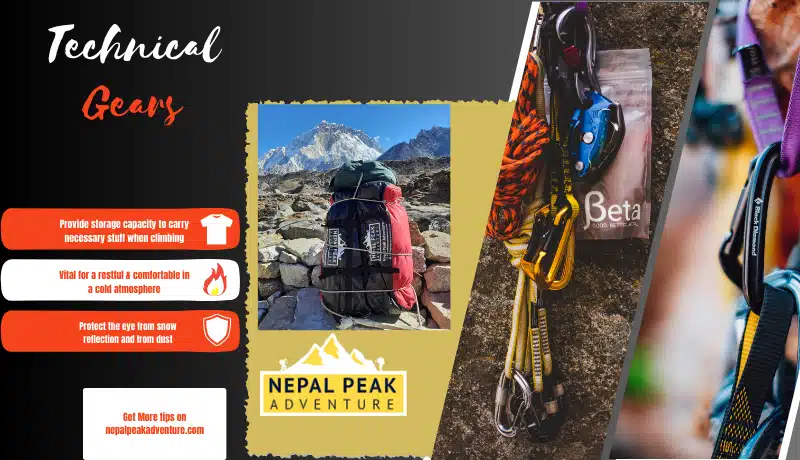
Backpack
A backpack is an essential piece of technical gear for Island Peak climbing. It provides the storage capacity and functionality needed to carry all your equipment, clothing, and supplies during the expedition.
A good backpack should have a sturdy frame, comfortable shoulder straps, and a hip belt for distributing the weight evenly. It should also have multiple compartments and attachment points for organizing gear and easy access to essential items on the go. Choosing the right backpack size and fit is crucial for comfort and efficient movement on the mountain.
Sleeping bag and sleeping pad
A high-quality sleeping bag and sleeping pad are vital for a restful and comfortable sleep during Island Peak climbing. The sleeping bag should be designed for cold temperatures and provide sufficient insulation to keep you warm throughout the night.
It should also be lightweight and compact for easy transportation. A sleeping pad adds an extra layer of comfort and insulation between your body and the ground, enhancing sleep quality and preventing heat loss. Look for a sleeping pad that is lightweight, durable, and offers adequate cushioning and insulation.
Trekking poles
Trekking poles are invaluable for providing stability, balance, and reducing strain on your legs and joints during the ascent and descent of Island Peak. They help distribute weight, improve traction, and provide extra support on uneven and challenging terrain.
Trekking poles also help reduce the impact on your knees while descending steep slopes. Look for adjustable and collapsible trekking poles that can be easily stored when not in use. Choose poles made of lightweight and durable materials that can withstand the demands of the climb.
Headlamp and extra batteries
A headlamp is an essential item for Island Peak climbing, as it provides hands-free illumination during early morning starts, late-night navigation, or unexpected delays. Opt for a headlamp that offers a bright beam, adjustable settings, and a long battery life. It is also crucial to carry extra batteries to ensure uninterrupted light throughout the expedition. Proper lighting enhances safety and visibility in low-light conditions, such as crossing glaciers or navigating rocky sections during dawn or dusk.
Sunglasses and goggles
Protecting your eyes from harsh sunlight, snow glare, and wind is crucial during Island Peak climbing. Sunglasses with UV protection shield your eyes from harmful rays and prevent snow blindness. Choose sunglasses with polarized lenses and a wraparound design for maximum coverage and reduced glare.
Additionally, goggles provide added protection against strong winds, blowing snow, and harsh weather conditions. Look for goggles with anti-fog coating and good ventilation to ensure clear vision and comfort.
Sunscreen and lip balm
Protecting your skin from the intense mountain sun is essential during Island Peak climbing. Apply a high-SPF sunscreen to all exposed areas of your skin to prevent sunburn and long-term sun damage. Don’t forget to protect your lips with a moisturizing lip balm that contains SPF.
The high altitude and reflective snow surfaces can increase the risk of sunburn, so regular reapplication is important. Keeping your skin and lips well-protected ensures comfort and reduces the risk of sun-related issues during the expedition.
V. Protective Gears from Elements
| Gears | Importance |
| Tents and shelters | Essential for providing protection and shelter during Island Peak climbing |
| Cooking equipment and fuel | Necessary for preparing meals and staying nourished during the expedition |
| Water bottles and hydration systems | Crucial during Island Peak climbing to maintain your energy levels |
| Food and nutrition | Vital for sustaining energy and maintaining physical performance during the climb |
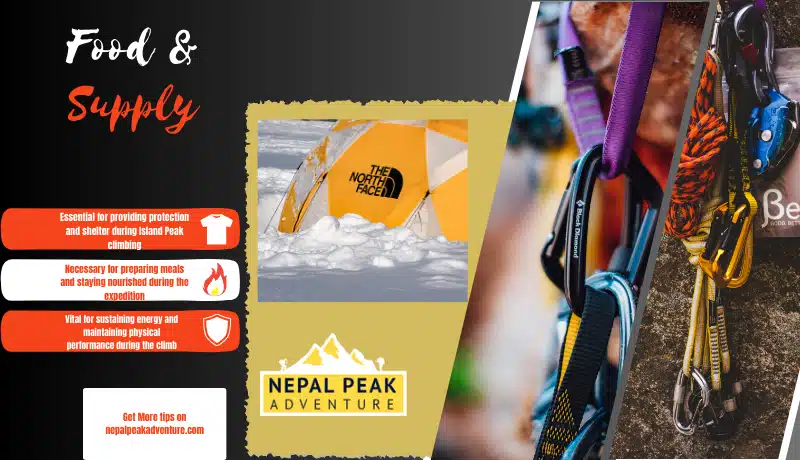
Tents and shelters
Tents and shelters are essential for providing protection and shelter during Island Peak climbing. A sturdy and reliable tent is your home away from home in the mountains, offering protection against wind, rain, snow, and cold temperatures. Look for a tent that is lightweight, durable, and easy to set up.
It should have sufficient space for you and your gear, as well as good ventilation to minimize condensation. Additionally, consider carrying a lightweight emergency shelter or bivvy bag as a backup option in case of unforeseen circumstances.
Cooking equipment and fuel
Cooking equipment and fuel are necessary for preparing meals and staying nourished during the expedition. A lightweight and compact stove, such as a backpacking stove, is ideal for cooking in the wilderness. Choose a stove that is efficient, easy to use, and compatible with the available fuel sources.
Carry a sufficient amount of fuel, considering the duration of your climb and any contingencies. Additionally, pack cooking utensils, pots, and pans that are lightweight and durable. Opt for utensils that can serve multiple purposes to minimize weight.
Water bottles and hydration systems
Staying hydrated is crucial during Island Peak climbing to maintain your energy levels and prevent altitude-related illnesses. Carry durable water bottles or hydration systems that are easy to access and refill. Insulated water bottles help keep your water cool and prevent freezing in cold temperatures.
It’s recommended to carry multiple water bottles to ensure an adequate water supply between water sources. Consider using hydration systems with a drinking tube for convenient access to water while on the move.
Food and nutrition
Proper nutrition is vital for sustaining energy and maintaining physical performance during the climb. Choose lightweight and high-calorie foods that are easy to prepare and consume. Pack a variety of non-perishable items such as energy bars, nuts, dried fruits, and dehydrated meals.
Include a mix of carbohydrates, proteins, and fats to meet your energy needs. Consider any dietary restrictions or preferences when selecting food items. It’s also important to plan your meals and snacks in advance to ensure you have enough food for the entire expedition.
VI. Navigation and Communication
| Gear | Importance |
| Maps and Compass | Essential for navigating through the terrain and orienting yourself |
| GPS Device | Provides precise location tracking and backup navigation |
| Communication Devices | Ensures communication in remote areas and aids in emergency situations |

Maps and compass
Maps and compasses are essential tools for navigating the terrain during an Island Peak climbing expedition. Carry detailed topographic maps of the area to help you navigate through different trails, valleys, and peaks. Familiarize yourself with the map symbols and contours to understand the landscape better. Additionally, a reliable compass is crucial for determining the direction and orienting yourself on the map. Learn how to use the compass effectively to navigate using landmarks and bearings. These tools provide a backup navigation system in case of GPS or electronic device failure.
GPS device
A GPS (Global Positioning System) device is a valuable tool for precise navigation and tracking your location during the climb. It uses satellite signals to determine your coordinates, elevation, and speed. With a GPS device, you can mark waypoints, track your route, and measure distances. Choose a GPS device that is rugged, waterproof, and has a long battery life. Load the device with detailed maps and ensure you understand its functions before the expedition. However, remember that a GPS device should not replace the traditional map and compass, but rather complement them.
Communication devices (satellite phone, walkie-talkies)
Communication devices such as satellite phones and walkie-talkies are important for staying connected and ensuring safety during Island Peak climbing. A satellite phone allows you to make calls and send messages from remote locations where cellular coverage is unavailable. It serves as a lifeline for emergency situations and enables communication with your support team or rescue services. Walkie-talkies, on the other hand, facilitate communication within your climbing group, especially when you’re spread out over a distance. They provide a quick and convenient way to relay information, coordinate movements, and address any emergencies.
VII. Safety Equipment
| Gear | Importance |
| First Aid Kit | Essential for treating injuries and illnesses during the climb |
| Emergency Shelter | Provides protection from extreme weather and emergency situations |
| Avalanche Safety Gear | Crucial for staying safe in avalanche-prone areas and aiding in rescues |
First aid kit
A well-stocked first aid kit is a vital component of your safety equipment during an Island Peak climbing expedition. It should include essential items such as bandages, adhesive tape, sterile gauze pads, antiseptic ointment, pain relievers, blister treatment, and any necessary prescription medications. Additionally, pack supplies for treating common ailments like altitude sickness, gastrointestinal issues, and respiratory problems. Ensure your first aid kit is easily accessible and that you are familiar with how to use its contents.
Emergency shelter
An emergency shelter is a critical gear item for unexpected situations such as extreme weather, getting lost, or injury. It provides protection from harsh elements and helps maintain body heat. Options include lightweight bivvy sacks, emergency blankets, or small, lightweight tents designed for emergency use. These shelters are compact, easy to carry, and can be quickly deployed when needed. Remember to practice setting up your emergency shelter beforehand to ensure you can do it efficiently in challenging conditions.
Avalanche safety gear (probe, shovel, beacon)
When venturing into avalanche-prone areas, it’s crucial to have the necessary equipment for avalanche safety. This includes a probe, shovel, and beacon. An avalanche probe is used to locate buried victims by probing the snowpack. A sturdy, lightweight shovel is essential for digging out trapped individuals. A beacon, also known as a transceiver, is a device that emits signals to aid in locating buried individuals. It is worn by climbers and allows for quick rescue in case of an avalanche. These tools, along with proper training in avalanche safety and awareness, significantly enhance your safety in avalanche terrain.
VIII. Personal Items and Miscellaneous
| Gear | Importance |
| Toiletries and personal hygiene | Essential for maintaining cleanliness and personal well-being |
| Cash and identification | Crucial for emergencies, fees, and identity verification |
| Repair kit and tools | Valuable for addressing minor equipment issues and making necessary repairs |
| Entertainment items | Enhances relaxation and mental well-being during downtime |
Toiletries and personal hygiene products
Don’t overlook the importance of maintaining personal hygiene during your Island Peak climbing expedition. Pack essential toiletries such as toothbrush, toothpaste, soap, shampoo, toilet paper, wet wipes, and hand sanitizer. Additionally, include any personal items you might need, such as contact lenses, prescription medications, and menstrual products. Keeping clean and practicing good hygiene helps prevent infections and ensures your overall comfort throughout the journey.
Cash and identification documents
It’s essential to carry sufficient cash and important identification documents during your climb. Keep some local currency for emergencies, as well as any fees or expenses that may arise. Carry your passport, permits, insurance information, and other identification documents securely in a waterproof pouch or bag. These items are crucial for verifying your identity, accessing restricted areas, and obtaining necessary assistance if required.
Repair kit and tools
Including a repair kit and essential tools in your gear is valuable for addressing minor equipment issues during the climb. Pack items such as a multi-tool, duct tape, spare parts, and lightweight cord. These tools can assist in fixing broken gear, making adjustments, and improvising solutions in case of equipment failures. Being self-sufficient with repair capabilities enhances your preparedness and minimizes potential setbacks on the expedition.
Entertainment items (books, cards, etc.)
While the focus of your climb is on the challenging adventure, it’s also essential to have some form of entertainment during downtime. Consider bringing entertainment items like books, playing cards, or a small musical instrument. These items can help you relax, pass the time during rest periods, and maintain a positive mental state. However, be mindful of the weight and space constraints, ensuring that entertainment items don’t compromise the overall efficiency of your gear.
IX. Conclusion
Recap of essential gear for Island Peak climbing
To summarize, the following gear is essential for a successful Island Peak climbing expedition:
- Crampons
- Ice axe
- Harness
- Helmet
- Climbing ropes
- Carabiners and quickdraws
- Ascenders and descenders
- Backpack
- Sleeping bag and sleeping pad
- Trekking poles
- Headlamp and extra batteries
- Sunglasses and goggles
- Sunscreen and lip balm
- Tents and shelters
- Cooking equipment and fuel
- Water bottles and hydration systems
- Food and nutrition
- Maps and compass
- GPS device
- Communication devices (satellite phone, walkie-talkies)
- First aid kit
- Emergency shelter
- Avalanche safety gear (probe, shovel, beacon)
- Toiletries and personal hygiene products
- Cash and identification documents
- Repair kit and tools
- Entertainment items
These gear items are crucial for safety, comfort, and success during your Island Peak climbing adventure. Ensure you have them in your possession and are well-versed in their proper usage.
Importance of proper preparation and equipment selection
Proper preparation and equipment selection plays a pivotal role in the success of your Island Peak climbing expedition. It is essential to thoroughly research and understand the requirements of the climb, including the terrain, weather conditions, and technical challenges. By having the right gear, you enhance your safety, comfort, and overall experience.
Each piece of equipment serves a specific purpose, whether it is providing traction on icy surfaces, ensuring a secure connection to ropes, or protecting you from harsh elements. The gear also enables you to navigate, communicate, and respond to emergencies effectively.
Additionally, proper preparation involves physical fitness training, acquiring the necessary skills, and obtaining the required permits and permissions. By being well-prepared and equipped, you increase your chances of a successful and enjoyable climb while minimizing risks.
Check out “How to train for Peak Climbing: Tips from Pro” for training programs.
Remember, the mountains are unforgiving, and the right gear and preparation can make a significant difference in your journey. Take the time to gather the essential gear, understand its importance, and ensure you are adequately equipped for the challenges that await.
With a comprehensive gear list and proper preparation, you are now ready to embark on your Island Peak climbing expedition. Stay safe, be prepared, and enjoy the incredible experience that awaits you in the mountains.
